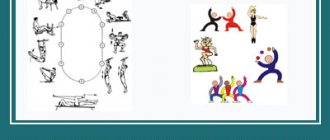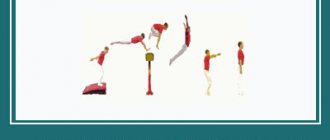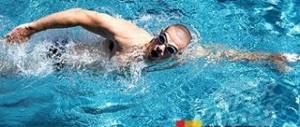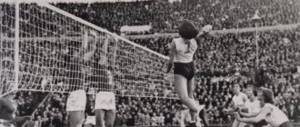The benefits of gymnastics for children
During the lessons the following develops:
- coordination. The child feels his body and knows how to control it;
- plastic. It will be very useful if you choose a sports career in the future;
- healthy musculoskeletal system;
- fight against excess weight. Many children suffer from this problem from an early age.
Additional benefits appear if children study not at home, but in clubs. There they will be able to develop not only physically, but also improve their communication skills and find new friends. And demonstration performances, if they are held at least for parents, help to gain self-confidence and not be afraid of the public.
It is important to adhere to proper nutrition. Without a routine and diet, gymnastics will be ineffective, and sometimes even harmful (for example, if you exercise immediately after a hearty lunch).
Psychologists say that gymnastics and the gradual development of muscle structure, endurance, and plasticity allow the child to understand that nothing can be achieved quickly and without difficulty. Children develop a correct outlook on life and realize that their goals are not achieved immediately.
Gymnastics for preschool children with sets of exercises
Gymnastics for children is of great importance, especially for the harmonious physical development and growth of the child. The earlier children are introduced to sports and physical education, the greater the guarantee that the younger generation will grow up strong and healthy. A modern child spends more and more time watching TV or at the computer, so physical education is vital for him.
The undeniable benefits of gymnastics.
The main advantages of gymnastics:
— The body is hardening. Strengthens immunity and endurance. It is recommended to conduct classes outdoors or in a well-ventilated area.
- Develops the skill of breathing correctly. During rhythmic movements, the general breathing technique is improved and the depth of inspiration increases.
— Coordination of movements and the ability to “feel” your body in space develop. The child’s movements become more “harmonious”.
— All organs of the young body are strengthened. Gymnastics is especially useful for children for the development of the musculoskeletal system. During physical exercise, correct posture is developed. Trained abdominal muscles ensure the proper functioning of the digestive organs. Metabolic processes are activated, helping to cleanse the body of toxins. Blood flow accelerates and the functioning of the nervous system improves.
— Obtaining new cognitive skills. When doing gymnastics, a child learns and remembers geometric shapes (walking in a circle, square), determines sides (turns to the right or left on command), learns to march to music, and develops the necessary rhythm of movements.
Types of gymnastics for children.
- Basic gymnastics. This type is based on general developmental, drill and basic movements. Gymnastic and sports equipment can be used - balls, jump ropes, hoops. The selection of exercises and dosage is carried out individually.
- Gymnastics. This type is more sport-oriented and has a distinctive feature - the obligatory elements of dancing to music. Classes have an emotional “coloring”, contribute to aesthetic education, the development of harmony, beauty and grace of movements. Exercises with objects are widely used: ribbons, flags, ball, hoop.
- Hygienic gymnastics. Physical exercises are combined with hardening water and air procedures and massage. This gymnastics for children is useful for strengthening health and immunity.
- Acrobatic gymnastics. Includes some elements of acrobatics that the child performs with the help of adults. Stretching and tumbling exercises require special care.
- Applied gymnastics. This includes therapeutic exercises or physical education, which help restore health with the help of a special set of exercises. Posture is corrected, the state of the nervous system improves, and the child’s general behavior and mood are normalized.
- Rhythmic gymnastics. In principle, this is basic gymnastics performed with musical accompaniment. Helps children develop a sense of rhythm, muscle freedom, and expressiveness of movements.
Exercises for children of primary preschool age (up to five years old).
At this age, kids are just getting acquainted with the basics of gymnastics for children with the help of game elements. Repeat the following exercises with your child five to six times. To avoid fatigue, take breaks periodically.
"Watch"
The child stands straight, with his arms down and his legs slightly apart. Then he begins to move his hands alternately, one forward, the other back, and vice versa, saying “Tick-tock.”
"Reach Up"
The baby stands with his feet shoulder-width apart. When entering, he raises his hands up, and when exiting slowly, he lowers them, saying “Uh-uh.”
"Woodcutter"
Starting position: put your legs apart, raise your arms and join them together. Leaning forward as you exit, place your joined hands between your legs. Rise as you inhale, arms up in the opposite position.
"Wave"
The child lies on the floor, arms at his sides, legs extended together. While inhaling, the baby raises his arms above his head and lowers them behind his head to the floor. Exhaling, he moves them in the opposite direction and slowly says “In-iii-iz.”
"Ball"
The baby lies with his back on the mat, folding his hands on his stomach, and imagines that he has an inflated balloon inside. The child, slowly inhaling air through the nose, inflates the “airy” tummy, then the breath must be held for 1-3 seconds. When you exhale slowly through your mouth, your tummy deflates. To make it more interesting for your baby, you can put a small pillow or soft toy on his stomach.
Exercises for children of senior preschool age (five to seven years old).
The main goal of gymnastics for children of this age is to prepare for school physical classes. Children can complete tasks on their own, gradually making them more difficult: using a gymnastic stick, homogeneous objects (for example, two flags).
"Crow"
The child stands with his feet shoulder-width apart. Hands down. When inhaling, he spreads them wide to the sides, and when exiting, lowers them, saying, stretching “Carrr”.
"Train"
The child stands straight, arms down. Then, bending your arms at the elbows, makes circular movements with them, like a train. You can simultaneously add slow running in place.
"Turns right, left"
Feet shoulder-width apart, stick held with both hands behind your back. Turn the body at an average pace to the right, then to the left. Breathing is even.
"Steps through a stick"
The child stands leaning forward. The stick is held in front in hands down. You need to step over the stick back and forth at a slow pace.
"Boat"
The child lies on his stomach, with his arms outstretched in front of him on the floor. Raising your shoulders and arms, you need to reach up. Exercise helps to develop correct posture.
Gymnastics classes are unique in that they can be practiced not only in a specially equipped room, but also while walking or on the sports ground. The important thing is to simply choose your exercises accordingly. If your child is interested in sports and likes gymnastics, then the best useful gift for him would be to purchase a ready-made sports corner or a children's sports complex.
Share on social media networks
RќСЂР°РІРёС‚СЃСЏ
Similar articles:
- Sports games for preschool children Methods of physical development for children Several…
- How to harden preschool children? The body of a small child is most often susceptible to colds, especially when you start...
- Gymnastics for pregnant women There are still debates in the scientific community about what...
- How to harden preschool children? Every parent has heard about the enormous health benefits of hardening a child...
- Games for preschool children Show yourself, share emotions with others, build your own imaginary…
- Communicative games for preschool children The importance of the preschool period for personality development is difficult to assess. IN…
- Child development. Role-playing games for preschool children Specialists in child pedagogy and psychology rightly noted that games for…
Post tags: child health
Features of children's gymnastics
Gymnastic exercises for children should first of all be adjusted to their age category . Children 3-4 years old are not able to perform complex and intricate movements, because they have not yet learned to control their body. And the task of training is precisely this training.
Exercises are also divided by gender . For boys, gymnastics is usually chosen for endurance, for girls - for the development of plasticity. When creating an individual training program, the personal characteristics of the child are taken into account. Some children at 3 years old are quite capable of performing the exercises of 5-6 year olds.
For girls and boys
Very young children are not allowed to do gymnastic exercises. They only change with age. Already after 7-8 years, it is clearly noticeable that girls are slightly inferior in strength and endurance to boys, with the same initial data. In subsequent years the difference becomes significant.
But there are several rules that are the same for everyone:
- Do not use home weights unless they are recommended by your trainer. Dumbbells or weights should be used by knowledgeable people. Children do not understand the capabilities of their body and are not familiar with the rules of physical activity. They may misdistribute their weight, leaving them injured for life;
- The younger the child, the shorter the gymnastics should be. It is better to introduce several visits a day, but no more than 5-10 minutes. Otherwise, children will become uninterested in studying and will stop trying;
- Do not lift heavy weights and do squats or other exercises with them. You can only work with your own body weight. This rule continues until posture is formed.
Boys are usually given exercises in which the load is distributed by the weight of their own body.
These include:
- squats;
- push ups;
- pull-ups on the horizontal bar;
- push-ups on parallel bars.
These exercises are also suitable for girls, but it is better to choose those that develop posture and grace in movements:
- leg-split;
- bridge;
- tilts in different directions;
- buckles on a jump rope or in length;
- training with stretching of different muscle groups.
Stretching cannot be done at home. It should be supervised by a trainer so as not to injure the child’s muscles and ligaments.
For different age groups
Gymnastic exercises for children and recommendations for building workouts can be viewed in the table:
| Age group | Basic Rules | Class time | Working with a trainer | Recommendations |
| 3-4 years | Lack of shoes, otherwise the foot apparatus will develop incorrectly; Constant repetition of exercises to develop physical memory | 5-10 min. | Mirror: children repeat the movement after the person who shows them | Musical accompaniment, a program based on dance and imitation of song characters |
| 5-7 years | Introducing complex coordination exercises and repeating them repeatedly | 10-15 min. | Single demonstration of exercise followed by counting | The game form of doing the exercises is preserved, but without music, so that children can clearly hear the count and follow the instructions |
| 8-10 years | Strength and acrobatic training elements are being introduced, and gymnastics for girls | From 20-30 min. | At the instruction level. The coach explains the actions, the child performs | Sports equipment is introduced, for example, you can climb a rope, jump on a trampoline or perform exercises on rings with elastic bands |
Physical exercise is required for a child at any age. When they become systematic, immunity increases. And children get sick noticeably less often than their peers.
Also, from the age of 8 years, body proportions are formed. Gymnastics helps keep them in harmony and set a healthy direction in development. Therefore, up to 8 years of age you can do training at home, but after that it is better to turn to professional trainers so as not to harm the child.
Set of exercises
Joint training between parents and child will help achieve the most effective results. When a baby trains with mom or dad, he looks at the correctness of the exercises performed. However, the pace of training for a child and an adult should be different: for a child, the number of approaches and intensity are reduced.
This is an opportunity to introduce children to physical education. The following list of exercises will help children have fun and strengthen their bodies:
- Boards. Place your elbows on the floor, rise up on your toes, and keep your back straight. Hold the position as long as you can. It’s great if the child holds in this position for 30 seconds.
- Squats. Place your feet shoulder-width apart and make deep knee bends, as if sitting on an invisible box. Lay out your hands. Make sure your knees don't go past your toes.
- Push ups. Keep your back straight: You can do this with a straight or bent knee.
- Cranks. Squats, but not completely, from the floor to the knee.
- Lungi. Take a step. Touch your other knee to the floor and make sure your front knee doesn't go past your toes.
- Lateral leg raises. Keep your legs straight. Legs rise left and right.
- Burpe. Quite a difficult exercise. The whole sequence makes your heart race. Squat down, then place your hands on the ground. Step your feet back, landing on your toes. Then do a push-up, tuck your legs under you, and jump straight off the floor.
- Mountain climbers. Start with push-ups, then alternate by bringing one leg at the same time forward to your armpit, and then release it. The exercise is similar to crawling.
- Butterflies. Lie on your back. Lift your feet just off the floor and shake.
- Squat into a V. Come back, extend your arms overhead to the floor, then lift your legs, torso, and arms until you're in a V. Reach toward your legs, then lower back down.
Before a set of exercises, a warm-up is always done to avoid muscle strains and injuries with bruises.
When and how long can you exercise?
If we are talking about regular exercises, then you need to do it every morning before breakfast. You can come up with an entertaining set of exercises that children will do while making the bed.
If we are talking about big professional sports, then the schedule will be as follows:
- 1-3 years – 2 times a week;
- 3-5 years – 3 times a week;
- from 5 years – more than 3 times a week.
There are also a few general rules to keep in mind:
- you can combine different sports, but take into account the total physical load on the child;
- 1 day must be a day off, completely free from intensive classes;
- the load increases gradually. During classes, the child improves physical fitness and endurance. Therefore, the regularity and intensity of training can be increased every year.
Every day you need to devote at least 60 minutes to physical activity. The younger the child, the more often they do exercises. It takes 5-10 minutes with breaks of 1-3 hours.
Advice from professional children's trainers on conducting gymnastics:
- the air in the room should be fresh. If possible, it is better to go outside, or ventilate the room well, and conduct the classes themselves with the windows open;
- comfortable clothes. It is important that it does not restrict movement and that the seams do not chafe;
- rule 8mi. For each approach, regardless of age, you need to do 8 different exercises, 8 approaches each;
- breathe through your nose. During physical activity, breathing becomes faster. When air passes through the nose, dust and small, almost invisible debris settle on the mucous membrane and hairs. The air also warms up and enters the lungs clean and warm. If you breathe through your mouth, then the exercise will do more harm than good, because frequent breaths will pollute your lungs much faster.
Psychologists say that the behavior of children depends not on upbringing, but on the example of their parents. Therefore, in order for a child to systematically do exercises, adults must show him how important this is.
We take into account age skills
Developmental gymnastics for children is carried out no later than 3 hours before going to bed at night. The optimal time is from 16 to 18 hours (after a nap and an afternoon snack, closer to the middle of the walk). It should consist of exercises that the child is able to master at a given age, and take into account his psychological characteristics.
For a 5-year-old child, the following nuances are important:
- it is difficult for him to concentrate on anything for more than 15 minutes - this is the maximum duration of the complex;
- he has a well-developed reaction speed, coordination of movements, dexterity (the child can catch and hit a ball, jump on two legs, as well as on one, and jump over obstacles);
- imaginative thinking is sufficiently developed, which makes it possible to carry out playful and imitative exercises, using children’s imagination;
- posture has practically formed;
- active growth continues;
- motor skills are not sufficiently developed.
Gymnastics for a 5-year-old child should help strengthen all muscle groups, develop coordination and flexibility of the baby. It is from this age that you can already enroll children in sports sections: dancing, swimming, figure skating. Girls often choose rhythmic gymnastics as the most aesthetic sport.
The degree of physical development allows children at this age to carry out a variety of exercises:
- without objects;
- using a ball;
- with a jump rope or rope;
- with a hoop;
- with a stick or other objects;
- gaming, including plot, simulating.
What could be the reason for giving up daily gymnastics? There are many contraindications for it. They were discussed in detail in the previous article.
When choosing a section for your child, take into account his abilities and personal inclinations. What seems like the best option for parents is not always interesting for children. Such activities will give the child nothing but frustration.
Contraindications
Gymnastic exercises for children, which need to be performed every morning, have almost no contraindications. If the child feels great and has no problems with joints or blood circulation, then you can safely start exercising, and constantly add new complexes, or increase the duration of old ones.
You should be more careful if you have health problems. Doctors consider the following list of contraindications:
- colds, any other temporary infections. While fighting the virus, your body temperature rises. And any physical activity raises it further, which can lead to complications and chronic diseases;
- inflammation. Body temperature rises, and gangrene and purulent infections may develop in areas of inflammation, as a favorable environment for bacterial growth is formed;
- bleeding. Physical exercise accelerates blood circulation, causing the flow to become even stronger;
- blood pressure problems. If they are temporary, then you need to stop morning exercises until recovery. When your blood pressure is constantly abnormal, you should consult your doctor. He will tell you what specific exercises you can do, and they will not harm your health;
- malignant tumors. With such serious diseases, the body should not be given additional stress, since it has to spend a lot of energy to fight the disease.
Physical activity is not recommended during the recovery stages. You need to give your body time to finally get stronger, and only after that resume gymnastics.
How to make classes not boring
If a child happily takes up gymnastics without additional motivation, no entertainment is needed. Exercise is a useful and mandatory event. Over time, children need to be taught to perform it, even if there is no musical accompaniment or other element without which classes were not started before.
To diversify gymnastic exercises, make them not boring and interesting, you can:
- allocate a sports place. Here the child can store his sports equipment and practice;
- buy sports equipment. Children work with their own weight, but still some things will come in handy - a jump rope, a ball, a mat for doing exercises in a lying position;
- musical background. It is best to select compositions from your child’s favorite cartoons. This way he develops pleasant associations with his activities.
Psychologists recommend avoiding gymnastics altogether if children are in a bad mood in the morning.
If you force someone to do it through force, a negative impression develops. Subsequently, the child will look for different ways not to do exercises. Experts from the Nemours Foundations report that playing with characters has a positive effect on exercise. Every day, different heroes are invented for the child (for example, a hunter or a rescuer). He tries on the role, and as if he is doing the exercises for another person. This approach helps to cope with laziness and overcome bad mood.
Preparing to charge
To prepare for charging, you can use the table:
| Nuances | Rules | What is it for? |
| Cloth | Tight-fitting, with a minimum of seams. Hardened children can work in shorts and a T-shirt even in winter | Loose and wide clothing can snag on sports equipment or interfere with normal joint movement |
| Shoes | Socks, leg warmers or special half shoes (sold in sports stores) | Do not interfere with the normal development of the foot, prevent the appearance of flat feet |
| Inventory | Balls, jump ropes, hoops (must be selected according to the child’s height) | Promotes bodyweight exercises |
| Additional items | Knee pads, mats for supine exercises | Does not wear out your knees, allows you to carry out the lesson comfortably |
Free space is allocated for charging. Usually the exercises are done in the living room near the TV, on which cartoon music is played.
Before you start charging, be sure to do a warm-up. It increases heart rate, breathing and warms muscles and tendons.
A high-quality warm-up prevents the occurrence of injuries during gymnastics.
Warm-up includes the following actions:
- Cardio warm-up. Exercise – walking in place with high knees;
- joint gymnastics. Exercises – alternate movement of joints;
- muscle stretching. Exercise – spreading your legs (splits), spreading your arms to the sides and back;
Gymnastic exercises for children to stretch muscles - restoration of breathing. Exercise – arms up as you inhale, down as you exit.
Examples of exercise therapy for children 5 years old
Exercise therapy is called physical therapy. Such activities are more practiced with newborns, but they are also useful for preschool children.
Complex of physical therapy for preschoolers:
- Varied walking on the balls of the feet with high knee lifts. This will prevent your baby from developing flat feet and club feet in the future.
- Swing your legs and arms. Extend your arms up to your sides, lifting your legs. As you inhale, the arms and legs rise, and as you exhale, they lower.
- Swings with a gymnastic stick. Raise the gymnastic stick up, inhale, lower it down - exhale.
- Bike. Lying on your stomach, raise your legs, butt should not rise from the floor.
- "Martin". Raise your upper torso until your pelvis comes off the floor.
- "Swimmer". Performed while sitting on half a chair, bending your knees. Make sure your child's back is flat and fairly straight.
It is very important to constantly monitor the correct position of the back and other parts of the body of children during physical therapy. It is necessary to breathe properly and deeply.
After physical therapy, breathing is restored in a state of calm. Classes are performed regularly with gradually increasing load.
Approximate sets of exercises for children at home
Gymnastic exercises for children are selected in full accordance with the age of the child. Depending on his physical abilities, a set of classes is formed.
Before starting gymnastics, a warm-up must be performed.
4-5 years
Exercises at the age of 4-5 years are aimed at muscle development.
A complex performed according to the instructions is ideal:
- The position is assumed lying on the stomach. The child needs to alternately raise his arms and legs up (as far as possible).
- The prone position is maintained. The child raises 1 arm and leg, while he learns to pull the toe on his foot.
- The child turns over onto his back. First, they raise their legs and do the “bicycle” exercise. Then it changes to “scissors”, when the legs are crossed in shifts.
- The “birch tree” exercise is performed while lying on your back. The legs are raised high, the toes are extended. Next, raise your hips and help them with your hands. Resting your elbows on the floor, your torso rises as high as possible, while keeping your legs in a level position. You need to hold this stance for 3-5 seconds.
- Take a standing position with your feet shoulder-width apart. Squats are performed. Parents need to make sure that the child is constantly breathing, because many people hold their breath until the exercise is completely completed.
- A kneeling position is assumed. Hands are extended forward and placed on the floor. You need to stretch, slightly swinging your body. The exercise is called "cat" because of the similarity in movements.
Each exercise is performed 8-15 times, depending on the child’s physical fitness.
6-7 years
The range of activities for preschoolers is changing. They require more space since most exercises are activity-based.
The complex is divided into stages:
- Run. There is no need to control that the child runs in a straight line or maintains a certain pace. He can wobble, accelerate and start walking quickly. Running time – 35-40 seconds.
- Jumping. Alternate jumps with a lunge forward, on one leg, in place and over a rope. Each pass is performed 15-20 times.
- Push ups. To begin with, use a surface approximately 40-50 cm above the floor level as a stop. Over time, the bar is gradually lowered until it reaches floor level. Performed 10-15 times.
When just switching to active exercises, their duration starts from 3-5 times (for running - from 15-20 seconds).
Over time, the number increases. This gradual increase in activity allows the child to adapt to the new rhythm without harm to health. You can add a ball game to the set of exercises. He is thrown into the wall, then caught. It’s better if parents and children take turns catching, then there will be more activity in the exercise.
8-10 years
There are a lot of gymnastic exercises for children 8-10 years old. Here the child will have to concentrate, since they involve stress on different muscle groups. You need to perform several actions at the same time, which requires concentration, which preschoolers lack.
Standard set of exercises:
- Starting position (hereinafter referred to as IP): arms along the body, legs together. Walking in place with high knees is performed. Time: 1 min.
- IP: similar. As you inhale, the arms rise up, and the left leg is pulled back, the toe is extended. On exhalation, IP is taken. Then the process is repeated with the right leg. For each, perform 10 approaches.
- IP: standing, feet shoulder-width apart, arms bent at the elbows, at the waist. Bends to the sides are performed, raising and extending the arm (if the tilt is to the right, the arm is left). Each incline requires 10 approaches.
- IP: legs spread wide, hands on the belt. As you exhale, you need to lean forward and reach with your left hand to the toe of your right foot. Then the process is repeated with the right hand, for each 10 approaches.
- IP: feet shoulder-width apart, arms bent at the elbows and palms connected in front of the chest. The body is rotated in different directions. At the same time, the elbows spread to the sides. Returning to IP, your elbows need to be pressed together. 10 approaches are performed for each side.
- IP: feet shoulder-width apart, hands on the belt. Partial squats are performed (when the angle of the bent knees is approximately 90 degrees). In this case, the arms are extended forward, but when lifted they return to their original position. Squats are useful for normalizing blood circulation, functioning of the digestive organs and training endurance. Therefore, there should be as many approaches here as the child can complete. The main thing is to maintain a moderate pace and take your time.
- IP: on the floor, emphasis is placed on the palms and toes. Perform regular push-ups 8-10 times.
- IP: standing, hands on the belt, legs slightly apart. Perform 30-40 jumps at a moderate pace. For experienced and resilient children, jumping rope is suitable.
- IP: as when performing 1 exercise. Walking in place is performed with a gradual slowdown in pace. Time: 1 min.
After 10 years, you can add sports equipment to the exercise to increase the load - dumbbells, weights. It is better to do this after consultation with a professional trainer.
Charging for children 5–6 years old
In older preschool age (5–6 years), the child’s cognitive and physical abilities actively develop. Daily exercise is no less important for a five-year-old than developmental classes in mathematics, reading, the environment, and other sciences offered to preschoolers. At this age, most sports sections are already available, but even visiting them does not negate the relevance of home physical education, and for those who do not play sports with professional trainers, exercises must be done with special care.
- What are the benefits of morning exercises for children 5–6 years old?
- What exercises should I offer a child at this age?
- How to interest your baby in an activity?
Let's figure it out together!
The benefits of morning exercises for preschoolers
Physical development
- Flexibility and plasticity;
- agility and coordination;
- strength and speed -
a well-chosen set of exercises promotes intensive development of physical performance, and also strengthens the cardiovascular, nervous and musculoskeletal systems. Agree, these arguments alone are enough to greet every new day with exercise.
Development of intellectual abilities
- Attention;
- memory;
- concentration -
In order to perform the exercises correctly, the child must demonstrate qualities that form mental activity. You can vary the methods of doing exercises: ask your child to repeat the exercises after you or give him verbal instructions. Of course, in the second case the task becomes more difficult, because the baby needs to figure out what exactly is required of him. But boys and girls 5–6 years old can do this task!
An outlet for emotions
- Jump and run;
- stretch your palms towards the sun;
- imagine yourself as a graceful cat or an active bunny -
morning exercises give a powerful charge of positive emotions, which makes it much easier to start the day in high spirits. You can use physical exercise to relieve the stress that has accumulated during the day. For example, diversify educational activities with outdoor games - this is also a good exercise that allows you to throw out emotions in an acceptable form.
Educational function
- Compliance with the regime;
- following instructions;
- overcoming laziness -
Children will not always perceive exercise with joy, but with a competent approach from adults, they develop their strong-willed qualities, learn diligence, and develop the habit of making efforts on themselves in order to achieve their goals.
Of course, your task, dear moms and dads, is to make sure that the moment of some coercion is minimal. And to do this, you need to offer your child interesting complexes, organized in a fun way.
How to do morning exercises: tips for parents
- If you have a choice between exercising at home or outside, always choose the latter.
- When exercising at home, do not forget to thoroughly ventilate the room before starting charging. The room should be clean and well lit.
- If you taught your child to do morning exercises from early childhood, doing exercises from the age of 2–3, or even earlier, then by the age of 5 the child can already perform the exercises independently. A beginner in this activity that is beneficial for children’s health needs your help. Do exercises with your child until it becomes a habit.
- You can compose sets of exercises yourself, having studied what movements are necessary for the harmonious physical development of a five-year-old, or you can use video lessons in which this work was done by professional children's trainers.
- Choose suitable music for morning exercises. Create several playlists: by changing them, you will add variety to your activities, which will help keep your child interested.
- Don't forget about such important components of exercise as warm-up and cool-down. They are needed to first set the body up for work (warm-up), and then return it to a calm state (cool-down).
- Control your child’s breathing while performing morning exercises. It should be smooth and deep. You must inhale through your nose (with your mouth closed), you can exhale through your mouth. At first, until you develop a habit, say out loud: “inhale,” “exhale.”
- At the age of 5–6 years, children already develop awareness and volition, but it is still not easy for them to concentrate on a serious activity for a long time. But if you offer exercises under the guise of a fun game, then exercise will turn from a duty into a favorite fun activity.
- Do not try, succumbing to sports zeal, to load your child with complex exercises. Exercise should give a surge of strength and energy, and not exhaust and tire.
- Charging time for children 5–6 years old should be 7–10 minutes.
Themed morning exercises for older preschoolers
"Gifts of Autumn"
On autumn days, an interesting option for morning exercises can be exercises accompanied by poetry. For the proposed exercises you will need a small ball.
| Words | Exercise | Qty |
| The harvest grew in the field, | Walking in place. Hands on the belt. Rocking the body from side to side | 30 s |
| Collect quickly. | ||
| The kids ran | Run in place. Arms are bent at the elbows and pressed to the body | 20 s |
| Collect ranetki. | Running with high knees | 5 s |
| We picked a lot of apples | IP: legs together. Hands with a ball below | 6 times |
| We stood on our toes. Hands raised. Pull the ball up | ||
| All the boxes were filled. | We lowered the handles down. Squatted down. | |
| Returned to IP | ||
| Picked onions and peas, | IP: we are on our knees. Hands with the ball are raised up. | 4 rubles each in each side |
| Our harvest is good | Alternately lean left/right | |
| They took out a round pumpkin, | IP: We stand straight. Feet together. Hands with the ball raised up | 6 times |
| Tilt down. We try to reach the floor with the ball. | ||
| Almost fell next to her. | We squat down. Hands down. | |
| Returned to IP | ||
| We picked tomatoes | IP: feet shoulder width apart. Hands with the ball extended forward | 4 rubles each in each side |
| They were scattered into buckets. | Bends alternately to the right/left leg | |
| And the pot-bellied zucchini, | IP: sitting on the floor, focusing on your arms laid back. Ball held between feet | 6–8 times |
| He fell slightly onto his side. | Raising and lowering legs at an angle of 30–45 degrees | |
| We collected watermelons | Sit on the floor with your legs bent at the knees (lotus position, or “Turkish”) | 8–10 times |
| They were thrown into the truck. | Throw the ball over your head and catch it | |
| And then with raspberries | Bring the ball to your face | |
| We blew away dust particles. | Blow on it, exhaling deeply through your mouth. | 4 times |
| We were going home | Jumping in place | 15 s |
| On a truck. | ||
| Open the gates | Calm walking in place | 30 s |
| The work is over. |
"Animal Charge"
The “animal” theme is fertile ground for exciting exercises with kids. You can perform movements to rhyming lines about animals, you can imitate graceful panthers, strong but clumsy bears or nimble little chickens. There is room for parental imagination to run wild! For example, you can do morning exercises using the following words:
| Words | Exercise | Qty |
| And kittens and chickens, | We stand straight. Feet together. Hands raised above head | 15 s |
| And lambs and puppies | Shake both hands | |
| They love exercise in the morning, | Marching in place | 30 s |
| To gain health. | ||
| The duck waves its beak | We stand straight. Feet shoulder width apart. Hands down, fingers reaching to the floor | 4 times |
| Repeat quickly, little one! | Head tilt forward/backward | |
| The cat turns his head | We stand straight. Feet together. Arms to the sides, palms tense | 4 times |
| You and I are not lagging behind. | Head tilt left/right | |
| The dog is stretching its paws, | We walk in circles on our toes. We pull our hands up | 30 s |
| He walks on tiptoes. | ||
| And the babies are chickens | We walk in circles on our heels. Hands on the belt | 30 s |
| They run on their heels. | ||
| And kittens and chickens, | Alternately stretch out both hands in front of you | 10 s |
| And lambs and puppies | Shake the brushes | |
| They stretch their legs, they stretch their wings, | We put our hands on our shoulders | |
| They are drawn towards the sun into the heavens. | Let's stand on our toes. Pull the handles up | |
| They stretch their legs, they stretch their wings, | Let's stand on our feet. We put our hands on our shoulders | Repeat 6 times |
| Drawn to the sun in the sky | Let's stand on our toes. Pull the handles up | |
| And then the animals | We stood up straight. Feet together. Arms extended forward. | 6 times |
| They pull their paws towards their paws. | Leaned forward. We reach out with our hands to our legs | |
| And when they get tired, | We stood up straight. Feet shoulder width apart. Hands on the belt | 6 times |
| The back is kneaded. | Bends back | |
| And then everyone jumps | We jump “feet together, feet apart”, clapping our hands above our heads | 15–20 s |
| And they kick their legs. | ||
| Everyone needs to rest | We stood up straight. Hands along the body | |
| Exhale - inhale. | We reached up. Hands above your head - inhale. Hands down - exhale | 15–20 s |
| We can continue | Calm walking in place | 20 s |
| Walk in a circle. | ||
| All! Stopped! | Curtsyed | |
| Bowed to each other |
Friends! We will be glad if our advice and sets of exercises help you introduce your baby to morning exercises. Let your children grow up healthy and happy!
Happy parenting to you. See you again!
Teaching gymnastic tricks
You can learn gymnastic tricks for a child whose physical abilities are good enough for this.
If you send children to professional sports from an early age, the following statistics are observed:
- 1.5-2 years. The child masters the simplest skills that develop his dexterity and the ability to group himself when falling.
- 3 g. The exercises are based on maintaining balance, and also stretch the muscles and develop flexibility.
- 4 g. The trainers gradually introduce the simplest tricks into the program - somersaults, splits, bridges, wheels.
- 5 years. Studying complex coordination movements separately, which will later be assembled into serious tricks.
- 6 years. Exercises on gymnastic apparatus are introduced. Difficult tricks are performed with insurance and under the close supervision of a trainer.
For a child to perform his first difficult trick, he needs to train for 4-4.5 years. The later children come to professional sports, the more difficult it is for them to develop flexibility, agility, and coordination. Therefore, teenagers will need much more time to perform the first trick.
Regardless of whether the classes are professional or home and amateur, gymnastic exercises are of great benefit for the development of children.
They affect not only their physical fitness and endurance. With the help of training, you can develop discipline, aspirations and desire to work on yourself and your skills.






